Widely recognised as one of the industry’s most innovative and forward-thinking companies, Universal Audio is celebrating 10 years of the game-changing Apollo interface in 2022.
We take a look at how this powerful interface has had a seismic effect on the recorded music industry and what it can bring to the table for you and your music production journey.

Currently on sale at a highly-attractive price point with a free plug-in promotion, there’s never been a better time to pick up a UA Apollo interface and join the ever-growing community of users.
From one man’s vision to an industry staple
 As a part of the industry for more than 60 years, the name Universal Audio should be familiar to every musician and producer. The brand has had an undeniable impact on the world of recorded music.
As a part of the industry for more than 60 years, the name Universal Audio should be familiar to every musician and producer. The brand has had an undeniable impact on the world of recorded music.
Founded in 1958 by Bill Putnam Sr, Universal Audio quickly became synonymous for their innovation.
They helped to develop the first modern recording console, the multi-band equalizer, and they soon stood at the forefront of stereophonic recording – to name just a few key milestones in UA’s history!
The post-war era of the Chicago music scene became the perfect platform for UA to grow as a brand. And with Putnam Sr producing giants of the industry, from Ray Charles and Nat King Cole to Frank Sinatra, it’s safe to say Universal Audio gear has featured on some of the biggest and best records ever.
The entrepreneurial spirit of Putnam Sr was the driving factor in the development of Universal Audio gear – he founded the brand in California to address the limitations of what studios were capable of.
This utilitarian viewpoint lead to the establishment of two other companies under Putnam Sr, UREI and Studio Electronics which produced the ubiquitous LA-2A and 1176 compressors and 610 tube recording console. These are heard on records from The Beach Boys and Sinatra to the eponymous Van Halen debut.
Revived and brought back to the market in 1999 by Bill Putnam’s sons, James and Bill Jr, Universal Audio continued where it left off.
With an aim to create better access to music creation for the modern age of producers, engineers and musicians, Universal Audio addressed new challenges facing recording techniques. And still, they retained their unrepentant commitment to delivering industry-leading products and quality.
Just like any good product, this is where the story of the Universal Audio Apollo range of audio interfaces begins.
A new chapter for music production
 Undoubtedly one of the most celebrated accomplishments in the company’s history, the 2014 release of the Desktop Apollo audio interfaces pushed Universal Audio into new territories.
Undoubtedly one of the most celebrated accomplishments in the company’s history, the 2014 release of the Desktop Apollo audio interfaces pushed Universal Audio into new territories.
The power of decades’ worth of research and development went into this compact desktop interface.
For the first time, an interface combined DSP technology and analog-modelled plug-ins to create a game-changing, all-in-one solution that was unheard of before then.
A statement of intent, Universal Audio assembled a team of some of the world’s best and brightest DSP modelling engineers to build an interface like no other.
It was not only an interface but an entire ecosystem and recording studio in one package.
Armed with a ‘no expense spared’ attitude, Universal Audio set to work on building the next evolution of audio interfaces.
They combined unrivalled audio clarity, AD/DA converters, and usability with the most authentic reproductions of classic analog recording equipment in plug-in format.
The result was an audio interface that lives and breathes, just like the analog equipment it was inspired by.
Working with the original manufacturers, golden units, and original schematics, the Universal Audio team have crafted software emulations of everything you could ever need in recording sessions.
Using equipment from brands such as Neve, Manley, API, Studer, Ampex, and Fender among more, Universal Audio captured the warmth and tone you’d expect from vintage hardware equipment for the next generation of producers.
The Apollo set a new precedent for what an audio interface is capable of, being heralded as the best audio interface for music production available. It meets the worldwide standard for the new age of professional producers and musicians.
Adopted by some of the biggest names in modern music, including Kendrick Lamar, Coldplay, Dr Dre, and Brad Paisley, putting your music in the hands of an Apollo is a smart choice.
A symbiotic relationship
Universal Audio makes equipment inspired by the needs of musicians, but many musicians will often get inspired by the gear itself.
The equipment found in the back catalogue of UA goes beyond just serving a purpose, it has been a key ingredient in shaping how records are made and how they sound to this day.
What can you expect from a Universal Audio Apollo interface?
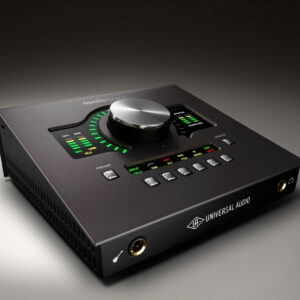 “World-class conversion with timeless analog sound”. It’s a fitting description that Universal Audio use for their Apollo range and we agree in every sense.
“World-class conversion with timeless analog sound”. It’s a fitting description that Universal Audio use for their Apollo range and we agree in every sense.
The choice for professionals at home and in commercial studios, UA’s Apollo range boasts superior A/D and D/A conversion with the tone, feel, and realtime workflow of classic analog recording for both Windows and Mac.
The Apollo range boasts industry-leading specifications across every aspect.
Whether it’s the compact and competitively-priced Solo or the expanded X4 interface, the sound of the Apollo is extremely detailed and open with unrivalled noise-floor levels and huge amounts of clean headroom for all microphone types.
Powered by award-winning Unison technology, preamps and instrument inputs can physically alter gain staging and impedance, modelling the colour and character of classic microphone preamps from Neve, API, and Manley to your input.
For both Mac and Windows users, you can enjoy all the benefits of the Apollo in ultra-high-speed connectivity at near-zero latency with both Thunderbolt and USB models. This is all packed in a sleek, rugged metal casing that is all but destruction-proof.
If it wasn’t clear why the Apollo is considered by many as the best audio interface, it should be now.
Why the Apollo is a different breed
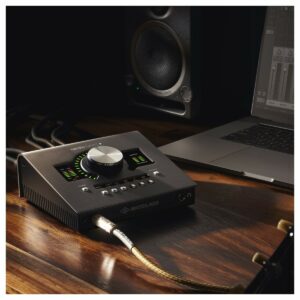 Whilst there are many fantastic audio interfaces available, the Apollo is unique.
Whilst there are many fantastic audio interfaces available, the Apollo is unique.
Imagine having a classic analog studio and stacks of rack equipment on your computer. The onboard DSP enables you to access award-winning UAD-powered plug-ins in real time for authentic analog tones before your audio hits your DAW.
With near-zero latency, you can create virtual signal chains, using everything from classic EQs, compressors, reverb, modulation, and more. It’s all possible without taxing your computer’s CPU processing, freeing it up for other processes and helping your system run smoothly, even on large sessions.
This means you can pre-process your tracks just as you would with hardware and record the processed tones into your session without needing to use any extra plug-ins or processors in your session.
In addition to onboard DSP processing and access to real-time plug-ins, the Universal Audio Apollo interface comes with Console functionality.
Taking care of your outputs, headphone mixes, and routing, Console acts as your virtual recording desk before your audio is processed in your DAW.
It’s ideal for setting levels or even creating AUX busses with reverbs and other effects. A highly flexible, streamlined, and intuitive program, Console runs separately from your DAW and gives you complete control over your audio. You can record or simply monitor the processing either on all inputs or on a per-channel basis.
As technology moves on and hardware improves over time, Universal Audio continue to update your Apollo interface’s software potential, meaning you won’t find yourself needing to update every generation of new interfaces.
Even the original 2012 Apollo runs with the current driver and Console app over Thunderbolt, so you can trust that your purchase of an Apollo interface will be a solid investment!
LUNA
Not only do all Thunderbolt Apollo interfaces come with the Apollo Console application, but they also come with free access to the analog-sounding LUNA Recording System (DAW) on Mac OS.
LUNA offers built-in analog tape emulation, classic Console summing, and slick workflow, providing total control over your Unison-preamps directly within the DAW session.
With industry-leading, phase-accurate multi-track drum editing and amazing sounding instruments such as Shape, LUNA adds excellent value to the Apollo ecosystem for Mac users.

An interface for every application
Regardless of how big or small your system needs to be, Universal Audio’s Apollo comes in a range of different models, providing every kind of musician and producer with the tools they need.
Solo
 The most affordable in the range, the Solo is small but mighty.
The most affordable in the range, the Solo is small but mighty.
Packed with the essentials, it delivers the complete Universal Audio experience in both sound and functionality through a streamlined, bus-powered Thunderbolt 3 desktop interface.
Featuring a single HI-Z input, twin Unison-enabled combination inputs, solo headphone output, and two stereo outputs for stereo monitoring, you have everything you need to record.
The Solo also houses a single DSP processing chip. So, creating extensive signal paths using onboard UAD plug-ins may not be possible due to processing limitations.
However, that doesn’t mean excellent-sounding recordings are out of reach. Pairing a Unison preamp flavour of your choice with some reverb and delay can lift your recordings to the next level.
The Solo comes included with 14 Legacy plug-ins. These are slightly stripped-down versions that reduce DSP requirements to a more manageable level, ensuring you can get the most from your sessions.
Perfect for guitarists, keys, or solo vocalists and musicians on the go, the Solo offers the same build quality, sound fidelity, and conversion as larger Apollo rigs. It also offers a modest amount of DSP for small amounts of processing to your tracks.
Shop now | Universal Audio Apollo Solo
Twin X
 The most popular unit in the line-up of UA desktop interfaces, the Twin is the hallmark interface within the Apollo range.
The most popular unit in the line-up of UA desktop interfaces, the Twin is the hallmark interface within the Apollo range.
With class-leading audio resolution and conversion, a single Hi-Z input, single headphone output, twin combination inputs, and four line outputs, the Twin offers enhanced versatility and functionality.
What’s more, the Twin features an optical input that the Solo does not, giving you up to eight additional inputs via ADAT for more recording channels.
The extra line outputs on the Twin also offer the ability to re-amp your signal through external processors from guitar amplifiers, pedals, or studio hardware, including compressors, EQs, or FX units.
Perfect for the at-home producer, mixing engineer, and professional musician, the Twin includes 14 of UAD’s premium-quality plug-ins to help enhance your tones at home.
Included in the plug-ins is the classic UA 610-B Unison-enabled tube preamp and EQ, which alters the gain stage and impedance of your microphone signal for access to the legendary 1958 UA console sound that is synonymous with Ray Charles and Frank Sinatra.
In addition, you gain access to stunningly accurate models of vintage guitar and bass amplifiers, as well as studio essentials, such as distortion pedals, classic EQs, compressors, reverbs, and the Precision Mix Rack collection for a suite of modulation and FX.
The Twin X comes in both Duo or Quad versions, offering two or four SHARC DSP chips respectively. Not only is the Twin X ideal for producers, but it’s also perfect for just about every kind of musician, from guitarist to singer, who’s looking for the perfect balance of power and portability. The Apollo Twin X can also function as a control room remote when coupled with an Apollo rackmount unit.
Shop now | Universal Audio Apollo Twin X DUO
Shop now | Universal Audio Apollo Twin X QUAD
Twin MK II
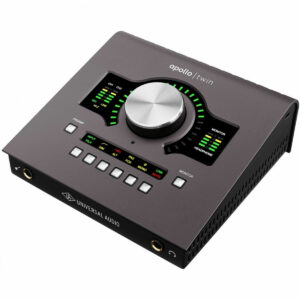 The previous generation of Apollo Twin, the MKII serves as a lower-cost entry point to the Twin platform for users of legacy Thunderbolt 2 systems.
The previous generation of Apollo Twin, the MKII serves as a lower-cost entry point to the Twin platform for users of legacy Thunderbolt 2 systems.
With two SHARC DSP chips and 2nd generation AD/DA conversion, the Twin MKII delivers the signature audio quality and workflow you’ve come to expect from Universal Audio in a more affordable package.
Much like the Twin X, the Twin MKII is the perfect interface upgrade for professional musicians looking to create a signature sound.
You can chain together a selection of the 14 included plug-ins at a cheaper price point than the Twin X.
Shop now | Universal Audio Apollo Twin Duo MKII
Apollo Twin USB Duo
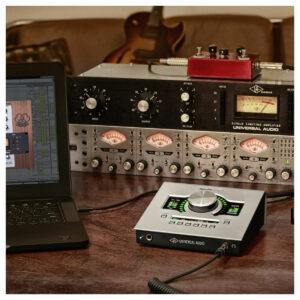 The Apollo Twin USB is a Windows-only version of the Apollo for users that don’t have access to Thunderbolt computers and need to rely on USB as their connection format.
The Apollo Twin USB is a Windows-only version of the Apollo for users that don’t have access to Thunderbolt computers and need to rely on USB as their connection format.
Twin USB offers the same classic Apollo workflow, amazing sound quality, and access to the UAD-2 processing as the Twin X and MK II via the onboard pair of SHARC DSP chips.
The same 14 plug-ins are also included with Twin USB to cover everything you’ll need in a typical recording session, from Unison-enabled preamps and guitar amps to classic compressors, EQs, and reverbs.
Much like the Twin X and MKII, the Twin USB is the perfect interface upgrade for professional musicians who use Windows and want to create a signature sound.
Shop now | Universal Audio Apollo Twin USB
Apollo Twin X DUO Gen 2
 The Apollo Twin X DUO Gen 2 comes as part of two bundles: the Essentials+ Edition (includes 33 premium-grade plugins) and the Studio+ Edition (includes 50 plugins). This interface has an improved dynamic range of 129 dB and ultra-low distortion; in fact, it has the lowest distortion of all the Apollos.
The Apollo Twin X DUO Gen 2 comes as part of two bundles: the Essentials+ Edition (includes 33 premium-grade plugins) and the Studio+ Edition (includes 50 plugins). This interface has an improved dynamic range of 129 dB and ultra-low distortion; in fact, it has the lowest distortion of all the Apollos.
As well as the award-winning plugins that come with the Twin X DUO Gen 2, there’s also powerful DUO Core DSP for real-time processing of these plugins. It’s designed to handle complex plugin chains and allow you to record and mix without latency.
New for the Twin X DUO Gen 2 is the Auto-Gain feature, an extremely useful function that speeds up the process of setting levels – particularly great when you need to adjust them on the fly.
And to ensure your masters sound great through any playback system, you can purchase the Apollo Monitor Correction Add-on and SoundID Reference licenses to use the interface’s Monitor Correction technology, powered by Sonarworks.
Shop now | Universal Audio Apollo Twin X DUO Gen 2 Essentials+ Edition + Studio+ Edition
X4
The flagship desktop Apollo, the X4 represents the complete desktop Apollo interface experience.
A bridge between the Twin X and rackmount X6, X8, X8p, and X16 models, the X4 comprises four Unison-enabled microphone inputs and four SHARC DSP chips, highlighting the tremendous amount of power available.
Inputs are increased from previous models, with two front-panel HI-Z D.I inputs and two headphone outputs, perfect for engineer and artist side-by-side recording sessions.
On the rear, the X4 boasts four Mic/Line, Unison-enabled inputs along with six line outputs divided into four line outputs and two dedicated monitor outputs. The addition of extra outputs is ideal for re-amping purposes or switching seamlessly between three pairs of stereo loudspeakers, the choice is yours!
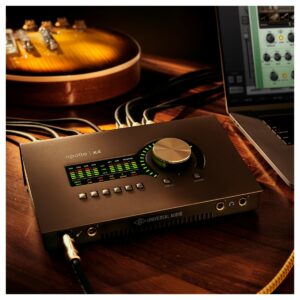 Should you find that you need more connectivity, an optical input and output are on hand to increase recording channels via 8-channel ADAT.
Should you find that you need more connectivity, an optical input and output are on hand to increase recording channels via 8-channel ADAT.
This huge increase in connectivity makes the Apollo X4 a must-have solution for recording engineers who work in professional studios with multiple musicians.
With four microphone inputs and two HI-Z, D.I inputs, recording a singer-songwriter’s vocals and guitar is made simple. Even recording an electric guitar and bass simultaneously is easy.
In addition to offering more power and I/O connectivity, the X4 is also the only desktop Apollo interface which comes with 16 plug-ins.
Including everything that’s present in the rest of the Apollo range, a classic 670-style compressor, and a Precision low-frequency enhancer, you can mix more freely with the X4 audio interface.
Shop now | Universal Audio Apollo X4
More reasons to upgrade
There’s no better time to upgrade your studio with world-class sound from Universal Audio. Coinciding with market-leading sale pricing, the purchase of a Universal Audio Apollo interface (excluding X4) between 1st November and 31st December 2022 will instantly unlock five premium UAD plug-ins (at a value of £879) – absolutely free!
Simply register your new Apollo before 15th January 2023 to receive this promotion. You’ll have the most accurate library of classic emulations right out of the box by manufacturers including Teletronix, Fairchild, Helios, and UA.

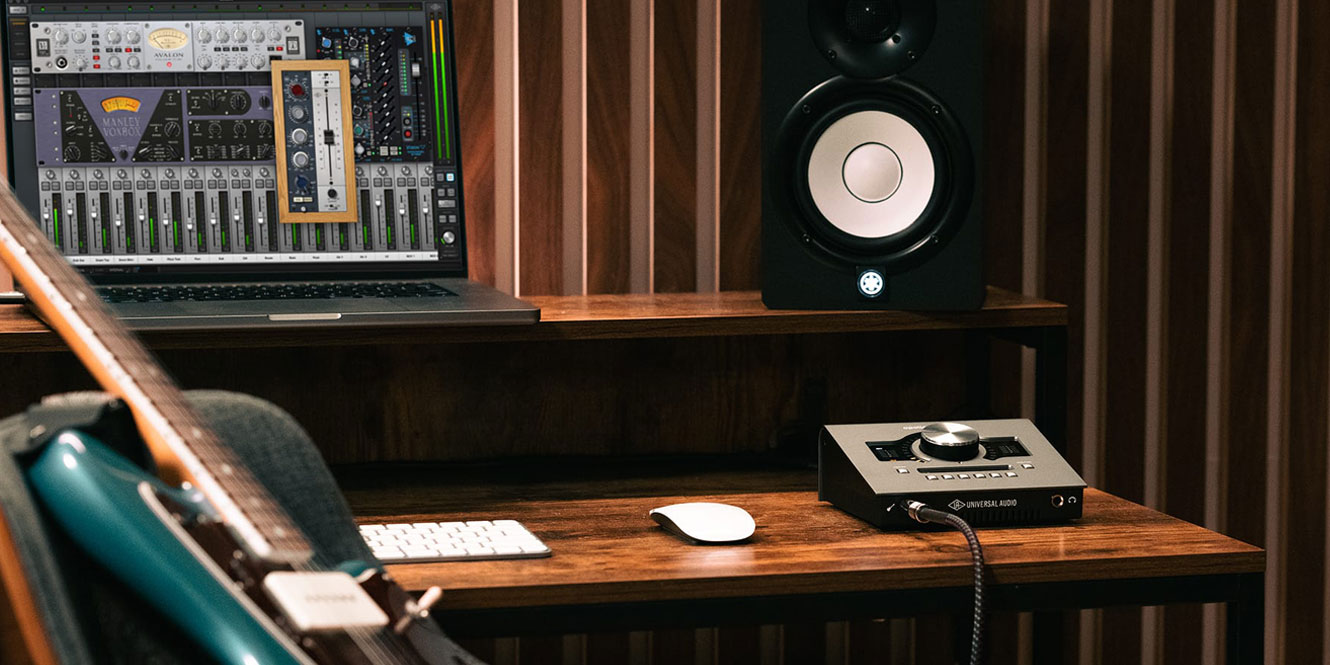











0 Comments